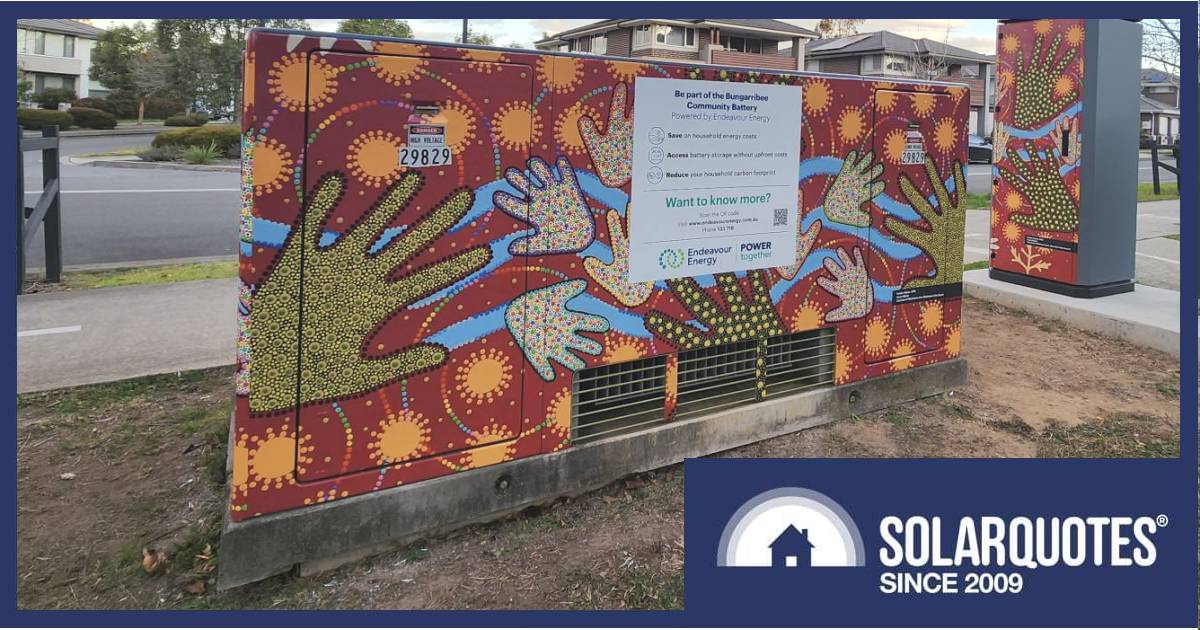
In New South Wales, Western Sydney’s first community battery trial seems to be delivering on its promise of cheaper electricity costs for participants.
A home solar battery is a great thing, but still an expensive thing. Community/neighbourhood batteries, depending on the model under which they operate, can provide access to virtual energy storage without the significant upfront cost.
Bungarribee Community Battery in the Blacktown local government area was formally launched in July last year as an Endeavour Energy initiative. It stores surplus energy from local solar installations, which is made available to participating customers to use; whether they have panels installed or not.
For customers without a solar power system (including renters), capacity was made available for a monthly fee, and their allocation is charged with surplus solar electricity from the area. Likewise, those with panels rent a portion of the battery to virtually store and access energy generated in the neighbourhood. An initial battery capacity limit was set at 4 kWh per household per day, and this costs $15 per month. 4kWh is less than a third of the useable capacity of a fully-charged Tesla Powerwall (13.5kWh).
It’s assumed that if local conditions mean little surplus, the battery is charged from the wider grid during the shoulder/off-peak timeframes when demand and wholesale electricity costs are much lower.
Participants receive a rebate directly to their bank accounts reflecting the savings made sourcing some of their energy needs from their allocation rather than the grid. While the trial is being carried out in partnership with Origin Energy, participants don’t need to be an Origin customer. Additionally, feed-in tariffs for solar owners aren’t affected – this is a totally separate scheme.
Does The Savings Estimate Stack Up?
Endeavour assesses whether participation is right for a household and calculates estimated savings before formal signup. It estimates a potential rebate of up to $300 per annum, even after payment of the participation fee is accounted for.
So, how’s that rebate estimate working out for Bungarribee Community Battery participants?
In a somewhat related article published by the ABC yesterday, I noticed one participant said he was seeing a return of about $40 on average a month. Take the $15 fee off and that leaves $25, or $300 a year in his pocket plus the feed-in tariff (if he has a solar power system). Not bad, particularly if this is indicative of what most participants are experiencing rather than an outlier case.
The Bungarribee Community Battery is fully subscribed. But Endeavour is rolling out others in locations where the network is currently, or is likely to, experience challenges batteries could help with – and where there are a high percentage of residents with rooftop solar panels. Registrations of interest in participation for trials in Shell Cove and Kiama Downs are currently open.
Bear in mind these are only trials – how the overall economics stack up and what the model will look like once the trials finish remains to be seen. You can find out more about Endeavour’s community battery rollout here.
Community Batteries Are Not For Everyone
While the idea of having a local battery soaking up solar electricity that can be accessed by residents is pretty popular, it’s very much a case of horses for courses. And not all of these projects allow the rental of capacity – some are just about taking strain off the local network. That is still a very good thing as it means more PV systems can be installed, and may avoid more expensive network upgrades – the costs of which are passed on to all.
But an article on The Conversation last year details why community batteries should only be pursued when they are clearly better than alternatives, such as transformer upgrades.
Across the border from New South Wales, a Victorian state government funded report from 2022 indicated community battery projects are not easily scalable and the model for operation used in one location may not necessarily transfer well to another. But that isn’t stopping Victoria from powering ahead – Round 4 of the Victorian Government’s 100 Neighbourhood Batteries Program will open for applications in August.

 RSS - Posts
RSS - Posts



All the benefits of a community battery are free. The notion of renting a portion of the battery to store excess solar power that allows it to be used later is nuts. It will happen regardless. In laymans terms all the homes and battery are on the same supply circuit with power from both going through the same meter at the fuse box being charged at the same rate.
Every community home will receive discharge power from the battery whether they rent a part of it or not.
For people without solar panels that rent part of the battery are just wasting money. Minister Penny Sharpe said they would benefit, nonsense. Critics state this scheme is inefficient, a much larger battery at a main sub station is better.